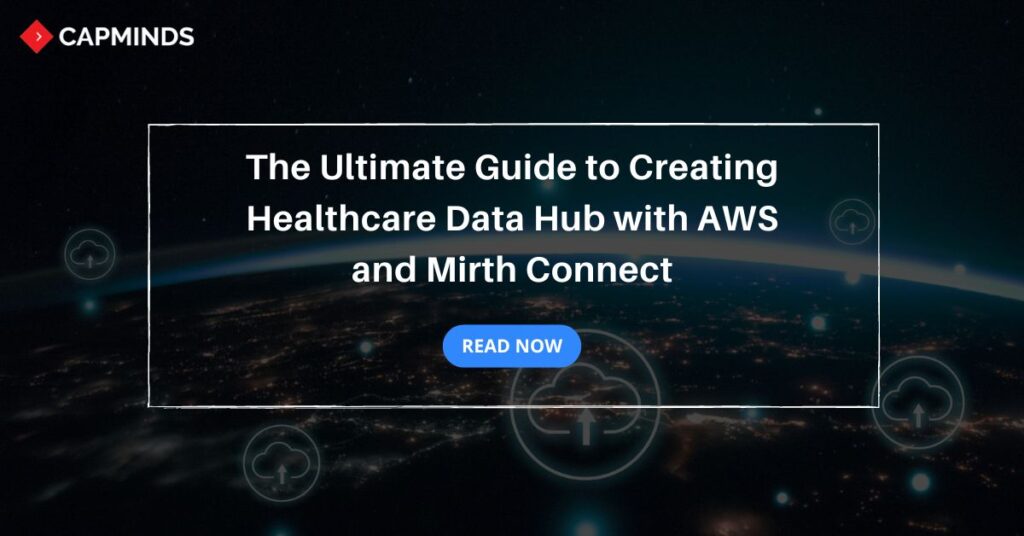The Ultimate Guide to Creating Healthcare Data Hub with AWS and Mirth Connect
Traditionally, healthcare providers used to take notes on paper during the patient interaction. The days are gone, and providers are more likely to enter the exam room with a laptop instead of notes and paper. This significant change aims to enhance patient outcomes and increase clinical workflow efficiency.
Transition to this change offers many advantages but is associated with many challenges as well. Each provider’s office maintains an electronic chart with patient information, but discrepancies can arise when records are duplicated or conflicting across different systems.
However, with additional datasets, we may leverage open-source software such as Mirth Connect and AWS services to work towards these and other objectives.
In this blog post, we have shared an overview of Mirth Connect, discussed various healthcare data types, and outlined essential steps for designing and deploying a reliable integration infrastructure on AWS.
The Overview of Mirth Connect
Mirth Connect is an open-source healthcare integration system. It enables healthcare data exchange between disparate systems. Using Mirth Connect, interoperability between various healthcare applications like EHR becomes easier by transforming and routing messages in various formats.
Mirth Connect supports multiple data types, such as HL7, CDA, DICOM, and more. It offers a simple interface for managing channels that are designed to handle certain data flows.
Healthcare organizations can use Mirth Connect to expedite communication, decrease errors, and improve patient outcomes by exchanging data more effectively.
Types of Healthcare Data You Should Know About
There are various types of healthcare data that you need to be aware of. Each serves different purposes within the healthcare ecosystem. Different types of healthcare data include:
- HL7 messages: HL7 messages are a standard format used for exchanging clinical and administrative data between systems.
- CDA and CDD formats: Clinical Document Architecture and Continuity of Care Document formats are used for sharing patient summaries and care plans.
- DICOM for medical imaging: Digital Imaging and Communications in Medicine are essential for transmitting medical images.
- CSV for data sharing: Comma-Separated Values format is commonly used for data sharing and import/export tasks.
Having a better understanding of each healthcare data type is important for effective data integration and interoperability in healthcare settings.
Key Considerations for Designing a Healthcare Application on AWS
When designing health applications in Amazon AWS, it is important to consider a few things which include scalability, security, and resilience.
- Healthcare organizations may experience fluctuation in datasets so it requires scalability solutions.
- Security is also critical as it ensures that sensitive health information is protected against unauthorized access.
- Architecture should be designed for resilience to allow for failover and disaster recovery solutions.
By prioritizing these factors, organizations may create a strong healthcare application that meets both operational and regulatory standards.
Related: Why DevOps is Crucial for Mirth Connect Integration on AWS (Step-By-Step Integration Process)
AWS Service Configuration
Configuring AWS is the initial step to setting up Mirth Connect. To start, the organization needs to create EC2 instances for hosting Mirth Connect and configure Amazon RDS for secure database storage.
This approach ensures that health data is preserved securely and easily accessible. It is also critical to use encryption technologies to secure sensitive data during transmission and storage. Furthermore, setting up DynamoDB enables organizations to store JSON-formatted communications flexibly.
1. Steps for configuring EC2 instances and RDS
- Configuring EC2 instances and Amazon RDS is a systematic process.
- First, users must select the appropriate instance type based on performance needs and anticipated data load.
- Next, AWS security groups should be configured to control inbound and outbound traffic to make sure only authorized access is allowed.
- After launching the EC2 instance, users can set up Amazon RDS by selecting the database engine and instance size suitable for their application.
- Verify that the database is appropriately encrypted and that backup mechanisms are maintained to protect patient data.
2. Data encryption and HIPAA compliance Necessity
- The healthcare sector often handles sensitive patient data, so, it requires security especially when using cloud services like AWS.
- It protects sensitive patient information from unauthorized access and ensures that data remains confidential during storage and transmission.
- HIPAA compliance mandates strict regulations regarding the handling of protected health information.
- Implementing encryption practices means healthcare organizations can mitigate risks associated with data breaches.
3. Setting up DynamoDB for JSON-formatted message storage
- Setting up Amazon DynamoDB for storing JSON-formatted messages is important.
- DynamoDB offers a flexible, scalable solution that accommodates varying data structures and access patterns.
- To configure DynamoDB, users can create tables with primary keys that uniquely identify records which ensures an efficient retrieval of messages.
- The schema-less nature of DynamoDB allows organizations to adapt their data models as needed without extensive downtime or reconfiguration.
- Utilizing DynamoDB enhances data storage capabilities, supports high-throughput operations, and simplifies integration with Mirth Connect.
Mirth Connect Deployment
Now, the deployment of Mirth Connect on the AWS environment. It involves various steps for successful installation.
- To begin, users must download the latest version of Mirth Connect and install it on their designated EC2 instance.
- Once installed, the configuration process involves setting up data sources, destinations, and channels that define how messages are routed and transformed.
- It’s also crucial to configure network settings, security groups, and firewall rules to facilitate smooth communication.
1. Configuring Mirth Connect with AWS Services
- Configuring Mirth Connect is important to make it work seamlessly with AWS services.
- Users can connect Mirth Connect to Amazon RDS for accessing patient data and utilize S3 for storing incoming and outgoing messages securely.
- Establishing connections with other AWS services, such as Lambda for processing and transforming data can further increase Mirth Connect’s capabilities.
- Mirth Connect’s proper configuration ensures that it can successfully handle data flows.
- It also maintains regulatory compliance and supports the interoperability demands of healthcare apps in the cloud.
2. Mirth Connect’s Command Line Interface Usage
- Mirth Connect’s CLI provides advanced users powerful tools for managing and automating various tasks.
- The CLI can be utilized for deploying channels, updating configurations, and monitoring performance metrics without needing to navigate the web interface.
- This capability is particularly useful for large-scale deployments where automation is necessary.
- Additionally, the CLI allows for batch processing of messages.
- Which can be integrated into scripts for scheduled tasks, and provides better control over the integration workflows.
CapMinds Mirth Connect on AWS with DevOps Service
Ready to enhance your healthcare data integration with Mirth Connect on AWS? CapMinds offers a comprehensive Mirth Connect Integration service tailored to meet your needs.
Our expert team ensures a seamless deployment, leveraging AWS’s power and DevOps practices’ efficiency. Our services include:
- Streamline your setup with Infrastructure as Code (IaC) using AWS CloudFormation or Terraform.
- Implement robust pipelines with tools like Jenkins or AWS CodePipeline for continuous updates.
- Utilize AWS CloudWatch and ELK stack for real-time performance tracking and logging.
- Benefit from IAM roles, encryption, and regular audits with AWS Inspector and AWS Config.
- Ensure automatic scaling with AWS Auto Scaling to manage varying workloads efficiently.
By utilizing our service, you can ensure a smooth integration of Mirth Connect on AWS and experience its full benefits.
Transform your integration process—Contact CapMinds today to get started!




